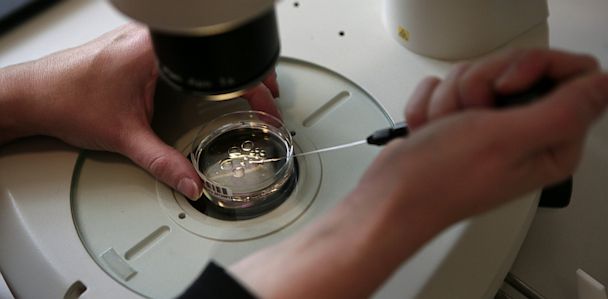3-Person IVF Could Get Green Light in UK

United Kingdom could have 3-person IVF. (Credit: Ulrich Baumgarten via Getty Images)
A few babies born in the United Kingdom could soon be the first in the world to have three parents - that is, their DNA could come from three different people thanks to an in-vitro fertilization technique designed to circumvent certain genetic diseases.
The U.K. government will draft regulations for three-person IVF this year, and it intends to introduce a finalized version for debate in parliament in 2014.
The goal is to prevent mothers from passing incurable and sometimes fatal mitochondrial disease, such as muscular dystrophy, to their children.
"Scientists have developed groundbreaking new procedures, which could stop these diseases from being passed on, bringing hope to many families seeking to prevent their future children from inheriting them," said U.K. Chief Medical Officer Sally Davies in a statement. "It's only right that we look to introduce this lifesaving treatment as soon as we can."
Click for more on the ethical debate of three-person IVF and uterus transplant.
The decision to push the techniques forward follows open consultation with the public in which U.K. citizens were asked how they felt about the treatment and the "social and ethical" questions it raises.
The public showed "overall support for the treatment," according to the government.
The mitochondria are the energy-producing parts of every cell - think of them as little batteries. As such, cells don't function properly if someone has a mitochondrial disease because cells can't turn food into fuel. For patients with Leigh's disease, for example, the mitochondria fail over time, and children often don't live past age 7.
Click here to read about Will, a Texas boy with Leigh's disease.
Mitochondrial DNA determines how the mitochondria will function, but it's only passed on from the mother. Nuclear DNA comes from both parents and determines children's characteristics, such as eye color and height.
Three-person IVF is also known as a mitochondrial transfer, and it would keep the nuclear DNA from both parents while swapping out the mother's "bad" mitochondrial DNA for a donor's mitochondrial DNA.
Scientists can do this using one of two techniques: They can swap the mitochondrial DNA before the mother's egg is fertilized, or they can fertilize two eggs (one from a donor and one from the mother) and take the part of the hours-old embryo (called a pronucleus) containing nuclear DNA from the intended mother and father and put it into the embryo with the donor's mitochondrial DNA. Only that embryo would be implanted into the mother's uterus.
Confused? Watch this illustrated video for a clear explanation.
Scientists have tested these techniques in animals but have yet to try them using human embryos. The treatment could save an estimated 10 lives a year, said the U.K. government. One in 6,500 babies are born with mitochondrial disease worldwide, and about 12,000 people in the U.K. live with it.
In the United States, 1,000 to 4,000 babies are born with mitochondrial disease each year, according to the United Mitochondrial Disease Foundation. But because mitochondrial disease can be misdiagnosed, the foundation says it's difficult to estimate how many people actually have mitochondrial disease.